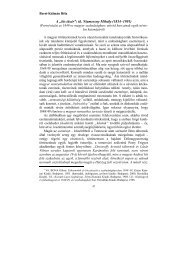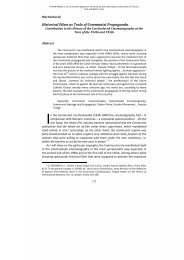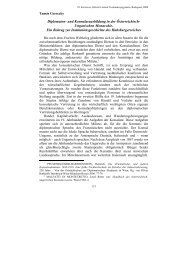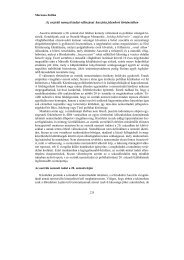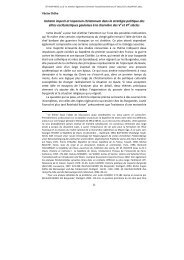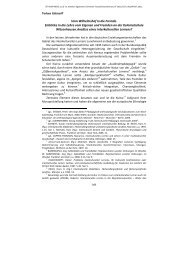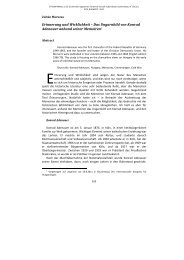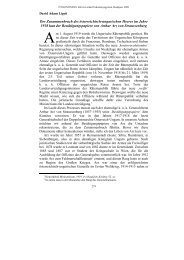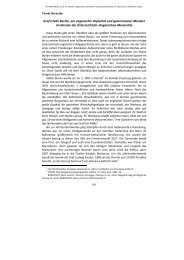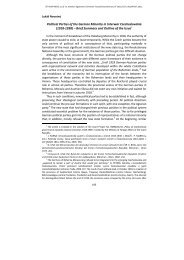You also want an ePaper? Increase the reach of your titles
YUMPU automatically turns print PDFs into web optimized ePapers that Google loves.
ÖT KONTINENS, az Új- és Jelenkori Egyetemes Történeti Tanszék tudományos közleményei, N o 2011/1.<br />
ELTE, BUDAPEST, 2012.<br />
László Gulyás- Loránt Bali<br />
<strong>The</strong> <strong>Fiume</strong> <strong>Question</strong> <strong>1918</strong>-<strong>1920</strong> ∗∗∗∗<br />
Abstract<br />
In October <strong>1918</strong> in the course of the dissolution of the Habsburg Empire a<br />
serious and adventureous period started in the life of <strong>Fiume</strong>. <strong>The</strong> Italian and the<br />
Croatian inhabitants started a heavy struggle for the city. <strong>The</strong> Hungarian governor<br />
and the officials did not see their lives in secure and fled. In November with the<br />
help of several warships and troops the Italians took control over the city. <strong>The</strong><br />
great powers were unwilling to give the city over to Italy. <strong>The</strong> <strong>Fiume</strong> question led<br />
to heated discussions in the Versailles peace talks. While the changing Italian<br />
governments and Versailles delegations made unsuccessful efforts to annex<br />
<strong>Fiume</strong>, on August 24 Italian nationalists and fascists launched a military action in<br />
order to prevent an agreement with the Southern Slav state to give the city over<br />
to them. Gabriele D’Annunzio declaired the military control over the city. <strong>The</strong><br />
prime minister Nitti disapproved of <strong>Fiume</strong>’s occupation. <strong>The</strong> moderate Italian<br />
inhabitants turned against D’Annuzio and his aspiration for a historical role. On<br />
November 12, <strong>1920</strong> the new Gioletti government signed an agreement with<br />
Yugoslavia in Rapallo. According to the agreement <strong>Fiume</strong> became a free state, but<br />
it enjoyed its free status for a few years only. In 1924 <strong>Fiume</strong> became part of Italy.<br />
Keywords: Dissolution of the Habsburg Empire, Italian-Croatian conflict, <strong>Fiume</strong><br />
question, Allied Forces, Southern Slav policy, Francesco Nitti, Gabriele D’Annunzio<br />
<strong>The</strong> <strong>Fiume</strong> <strong>Question</strong> in the Fall of <strong>1918</strong><br />
n October <strong>1918</strong> the dissolution of the Habsburg Empire was already in an<br />
irreversible state and the national councils of several of its nations<br />
proclaimed their intention of either seceding from the Empire, or joining a<br />
newly forming state. 1 <strong>Fiume</strong> was part of this series of events. 2<br />
On 16 th October, <strong>1918</strong>, Emperor Charles IV announced that the Austro-<br />
Hungarian Monarchy was to be transformed into a federal state. 3 I<br />
It was also<br />
stated that <strong>Fiume</strong> would either become part of Croatia, or, of the newly founded<br />
Southern Slav Kingdom. Two days later <strong>Fiume</strong>’s representative in the Hungarian<br />
∗<br />
<strong>The</strong> Project is supported by the European Union and co-financed by the European Social Fund<br />
(grant agreement no. TAMOP 4.2.1/B-09/1/KMR-2010-0003).<br />
1<br />
<strong>The</strong> details see SIKLÓS András, A Habsburg-birodalom felbomlása <strong>1918</strong>: A magyarországi<br />
forradalom, Kossuth Kiadó, Budapest 1987, 126-143.<br />
2<br />
PAP Norbert, L'Ungheria ed il Mediterraneo. Il carattere geografico dei rapporti fra l'Ungheria e gli<br />
stati dell' Europa meridionale, Imedias Editore, 2008, 159.<br />
3<br />
ZÖLLNER, Erik, Ausztria története, Osiris Kiadó, Budapest 2000, 369.<br />
143
László Gulyás - Loránt Bali: <strong>The</strong> <strong>Fiume</strong> <strong>Question</strong> <strong>1918</strong>-<strong>1920</strong><br />
parliament, Andrea Ossoinack, held a parliamentary speech, in which he<br />
emphasized that <strong>Fiume</strong> had never been part of Croatia; it was Italian and it should<br />
remain a part of Italy. 4<br />
In October <strong>1918</strong> parallelly two national councils came into being in the city. On<br />
the one hand it was the Italians who set up the Italian National Council of <strong>Fiume</strong>,<br />
and, on the other, the Croatians brought about the <strong>Fiume</strong> Committee of the<br />
Zagreb National Council. <strong>The</strong> birth of these two parallel bodies is indicative of the<br />
fact that the Italian-Croatian struggle for <strong>Fiume</strong> started. <strong>The</strong> Croatian army<br />
entered <strong>Fiume</strong> on October 23. <strong>The</strong> last week of October in <strong>Fiume</strong> can best be<br />
described by marching soldiers. In several of the city’s streets Croatian soldiers<br />
marched under their Croatian flag, while in other streets it was the Italians who<br />
marched under their Italian flags. 5<br />
This situation rightfully raises another question. Where were <strong>Fiume</strong>’s<br />
Hungarian leaders and inhabitants during these events? <strong>The</strong> answer to this<br />
question is simple. Zoltán Jékelfalussy, <strong>Fiume</strong>’s last Hungarian governor, having<br />
realised that the Hungarians did not stand a chance to fight back the Italian or the<br />
Croatian crowds of demonstrators, left for Budapest on October 28th. After the<br />
governor left, the office holders of the Hungarian state, including public servants,<br />
employees, soldiers, policemen, office workers, railwaymen, also fled. In the city of<br />
<strong>Fiume</strong> these groups of Hungarian people did not see their lives and their future<br />
secure. 6<br />
<strong>Fiume</strong>’s Italian population, as well as the Croatians aimed at solving the<br />
situation for their own good. In order to come to a decision, the Italian National<br />
Council of <strong>Fiume</strong>, presided by Grossich Antonio, in the city’s main square on<br />
October 30, <strong>1918</strong> proclaimed the city’s annexation to Italy. 7 <strong>The</strong> Italian-Croatian<br />
rivalry is illustrated well by the fact, that the official Croatian delegation arrived<br />
from Zagreb on the very same day to take charge of the city. Comissar Rajčevič,<br />
head of the delegation, moved into the governor’s mansion. Antonio Grossich<br />
immediately protested in the name of the Italian National Council and declared<br />
that they would support the union with their mother country, i.e. Italy, and look<br />
upon the Southern Slav occupation as a temporary situation. During the following<br />
days the Croatian-Italian conflicts were becoming strained in <strong>Fiume</strong>. One of the<br />
special features of this relationship was the changing of the flags. <strong>The</strong> Croatians<br />
removed the Italian flags from the buildings, while the Italians did the same with<br />
the Croatian flags. On public buildings this changing of the flag took place on<br />
several occasions. In addition, there were a lot of violent crimes, looting, burglary<br />
and theft.<br />
4<br />
FRIED Ilona, <strong>Fiume</strong>, Enciklopédia Kiadó, Budapest 2004, 22.<br />
5<br />
HORVÁTH József, A magyar <strong>Fiume</strong> végnapjai 1914-1924, Hadtörténelmi Közlemények, 2003/1.<br />
szám 172-175.<br />
6<br />
HAJDÚ Zoltán, <strong>Fiume</strong> (Rijeka) kérdéséről. IN: PAP Norbert (szerk.), A Balatontól az Adriáig, Lomart<br />
Kiadó, Pécs 2006, 104-109.<br />
7<br />
FRIED 2004, 22.<br />
144
ÖT KONTINENS, az Új- és Jelenkori Egyetemes Történeti Tanszék tudományos közleményei, N o 2011/1.<br />
ELTE, BUDAPEST, 2012.<br />
On 4 th November two destroyers, the Stocco and the Sirtary got into the<br />
harbor. <strong>The</strong> commander of the fleet was Admiral Rainer, who, in front of the<br />
Italian City fathers of <strong>Fiume</strong>, who had come to greet him, announced that he had<br />
come in the name of the king of Italy and also that he would do everything in his<br />
power to defend <strong>Fiume</strong>’s Italian population. 8 During the following days several<br />
other warships arrived and on 17 th November Italian land forces – troops of<br />
general San Marzano - also appeared. In order to avoid conflict with the Italian<br />
armed forces, the Croatian troops left the city on the very same day.<br />
In addition to the Italian soldiers in November <strong>1918</strong> Allied Forces troops, including<br />
the Americans, the British and the French, also arrived in <strong>Fiume</strong>. <strong>The</strong>y came, because<br />
the great powers that made up the Allied Forces, were unwilling to give the city over to<br />
Italy. <strong>The</strong> presence of the Allied troops did not prevent the Italians from considering<br />
<strong>Fiume</strong> as a city of their own. On November 28, <strong>1918</strong> Cagni, an Italian general, while<br />
paying a visit to <strong>Fiume</strong>, was greeted with outstanding ovation by the local Italians. In<br />
his speech the general announced: ’This is our land. And it will remain ours.’ 9<br />
This utterance was taken seriously by the Italian inhabitants of <strong>Fiume</strong>, who<br />
started to follow an ’Italian way of life’ in the city by undertaking the following<br />
steps: in January 1919 all postal stamps, 10 then the banknotes were stamped over<br />
and the schools were taken over. In August 1919 the background of <strong>Fiume</strong>’s public<br />
servants was investigated and only those could continue in their jobs, who were<br />
approved and taken over by the Italian National Council. <strong>The</strong> others were forced to<br />
leave the city. 11<br />
<strong>The</strong> <strong>Fiume</strong> <strong>Question</strong> in the Peace Conference<br />
<strong>The</strong> <strong>Fiume</strong> question led to heated discussions in the course of the Versailles<br />
peace talks, starting in January 1919. Within this context the <strong>Fiume</strong> question was<br />
part of a larger problem. This so-called ’Italian’ problem was rooted in the fact<br />
that in 1915 it had been absolutely essential for the Allied Forces to engage Italy<br />
on their side. On April 16, 1915 a secret treaty was signed in London and the<br />
Allied Forces promised Italy the possibility of a territorial expansion of<br />
considerable scale, including the area of South Tirol, other areas in the<br />
Mediterranean region, such as Trieste and its neighbourhood, the islands of the<br />
Kvarner Gulf, the northern part of Dalmatia (including the port of Zara), some<br />
islands in southern Dalmatia and part of Albania (Valona). 12<br />
<strong>The</strong> problem was also rooted in another fact, namely, that the Allied Forces<br />
had promised Serbia certain areas of the Adriatic region, namely the Croatian<br />
8<br />
HORVÁTH 2003, 176.<br />
9<br />
HORVÁTH 2003, 178.<br />
10<br />
FRIED Ilona, Emlékek városa <strong>Fiume</strong>, Ponte Alapítvány, Budapest 2001, 186.<br />
11<br />
HORVÁTH 2003, 181.<br />
12<br />
ROMSICS Ignác, Nemzet, nemzetiség és állam Kelet-Közép- és Délkelet-Európában a 19. és 20.<br />
században, Napvilág Kiadó, Budapest 1998, 160.<br />
145
László Gulyás - Loránt Bali: <strong>The</strong> <strong>Fiume</strong> <strong>Question</strong> <strong>1918</strong>-<strong>1920</strong><br />
areas including <strong>Fiume</strong>, and the larger part of Dalmatia, meaning that the same<br />
areas had been promised both to Italy and Serbia. 13 Wilson, U.S. president thought<br />
that the way out of the awkward situation was to theoretically denounce and<br />
nullify all secret treaties. Wilson could come up with this proposal because he had<br />
not been among the signatories of the London treaty.<br />
It is also important to note that in general Wilson led a pro-Serbia policy (or,<br />
rather a Southern Slav policy) and he believed that southern Slav interests should<br />
seriously be taken into consideration in order to achieve stability in the Balkans.<br />
<strong>The</strong>se considerations made the American president disregard Italy’s claims during<br />
the peace talks. 14 In addition, neither the French, nor the British delegation stood<br />
by Italy.<br />
As a result, the Italian delegation faced a very serious dilemma and they had<br />
two alternatives. One of these options was to insist on the resolutions of the<br />
secret treaty of London. In this case they would have to give up <strong>Fiume</strong>, since its<br />
possession had not been mentioned in the London treaty. Or, as a second<br />
alternative, they would give up the London Treaty, or, some parts of it, and they<br />
could claim certain territories on ethnic basis, including <strong>Fiume</strong>.<br />
At the same time a third plan was emerging. It was Orlando Vittorio Emanuele,<br />
Italy’s prime minister of that time, and Sidney Sonnino (foreign minister in<br />
Orlando’s government), who elaborated a third scenario, by which they would<br />
claim areas based on the Treaty of London, as well as the annexation of <strong>Fiume</strong>.<br />
This third version was absolutely unacceptable for the Allied Forces. Thus the<br />
Italian territorial claims were in danger. When it became clear for the Italians in<br />
the course of the peace negotiations, Orlando left for Italy in March 1919. But<br />
since the process of drawing the borders continued in his absence as well, several<br />
weeks later he decided to return and resume the talks.<br />
<strong>The</strong> question of <strong>Fiume</strong> was discussed after Orlando’s return. On April 3, 1919<br />
Orlando had a significant speech in a meeting of the Council of Four, explaining his<br />
view of the <strong>Fiume</strong> question. 15 In his explanation the question of <strong>Fiume</strong> had not yet<br />
been mentioned in the treaty of London, because at that time the total dissolution<br />
of the Austro-Hungarian Monarchy had not yet been seen. But, he argued, now<br />
<strong>Fiume</strong> was to be handed over to Italy both for economic and ethnic reasons. One<br />
of his arguments was that the Croatians and the Slovenians, both nations having<br />
been parts of the Habsburg Empire, were hostile towards each other, so, meeting<br />
Italy’s territorial claims was both acceptable and reasonable in this situation.<br />
Neither Wilson nor Clemenceau accepted the Italian arguments. But since the<br />
peace conference concentrated on the elaboration of the German peace treaty,<br />
they temporarily put off the solution of the <strong>Fiume</strong> question.<br />
13<br />
PÁNDI Lajos, Köztes-Európa 1763-1993. Térképgyűjtemény, Osiris-Századvég, Budapest<br />
1995, 266.<br />
14<br />
ORMOS Mária-MAJOROS István, Európa a nemzetközi küzdőtéren, Osiris Kiadó, Budapest,<br />
1998. 255.<br />
15<br />
KIS Aladár, Olaszország története 1748-1968, Akadémiai Kiadó, Budapest 1975, 140.<br />
146
ÖT KONTINENS, az Új- és Jelenkori Egyetemes Történeti Tanszék tudományos közleményei, N o 2011/1.<br />
ELTE, BUDAPEST, 2012.<br />
On April 19, 1919 the Council of Four once again put the issue on their agenda.<br />
Orlando was once again given the opportunity to enumerate his economic, political,<br />
national, strategic and historical arguments. Wilson was still unyielding and he ruled<br />
out the possibility of <strong>Fiume</strong>’s<br />
annexation by Italy. At the same time<br />
he supported the recommendation, by<br />
which all Dalmatia be annexed to the<br />
new southern Slav state while <strong>Fiume</strong><br />
be made a Free State, controlled by<br />
the League of Nations. 16 It should also<br />
be noted that even in some circles of<br />
<strong>Fiume</strong>’s Italian citizens the trend of<br />
supporting their city’s free status was<br />
well known.<br />
On April 23, 1919 Wilson issued a<br />
proclamation to the Italian people, in<br />
which he repeated his recommendation.<br />
Orlando responded with a counterproclamation,<br />
then, as a protest, on<br />
April 24 he once again left the<br />
conference venue. On May 6, 1919 he<br />
returned, but he had to leave again –<br />
this time for good due to internal<br />
political reasons. On June 19, 1919 the<br />
Italian parliament withdrew their<br />
confidence from Orlando’s government<br />
147<br />
Italian-Yugoslav territorial dispute 1915-1924<br />
Source: GOLDSTEIN, Ivo: Croatia. A History.<br />
Hurst Company. London. 114<br />
(262 yes and 78 no votes), thus on June 2 Orlando had to resign from his position<br />
as prime minister. 17<br />
It is also to be noted, that the unwillingness of the peace conference to meet<br />
all the territorial claims of Italy resulted in the emergence of the notion of ’vittoria<br />
mutilata’ (mutilated victory) in the public opinion. Its logic is as follows: 18 the<br />
Italians’ bloodshed and sacrifice in the war were all in vain; the unfaithful allies<br />
(the U.S, England and France) betrayed and dispossessed them and deprived them<br />
of the fruits of victory. Consequently, the Italian victory is infact a defeat. <strong>The</strong><br />
nation’s task is clear in this situation and it is to strive for real victory.<br />
After Orlando’s fall Francesco Savario Nitti became the next prime minister, whose<br />
government was in power from June 1919 through June <strong>1920</strong>. 19 Nitti and the new<br />
Versailles delegation, Tommaso Tittoni and Victor Scialoja, were of more moderate<br />
16<br />
HERCZEGH Géza, A szarajevói merénylettől a potsdami békekonferenciáig, Magyar Szemle<br />
Könyvek, Budapest 1999, 105.<br />
17<br />
KIS 1975, 141.<br />
18<br />
KIS 1975, 140.<br />
19<br />
HEARDER, Harry, Olaszország története, Maecenas Könyvek, Budapest 1992, 190.
László Gulyás - Loránt Bali: <strong>The</strong> <strong>Fiume</strong> <strong>Question</strong> <strong>1918</strong>-<strong>1920</strong><br />
views in foreign affairs. <strong>The</strong>y cut back on Italy’s territorial claims. Eventually their<br />
claims were approved by the Versailles conference and Italy could annex South<br />
Tirol and the port of Trieste. It is interesting to note that Trieste, as well as the<br />
French-occupied Strasbourg were the two most populous cities, acquired by the<br />
Allied Forces in the aftermath of the war. 20 Nitti’s foreign policy in relation to the<br />
<strong>Fiume</strong> question concretely meant that Italy was trying to come to an agreement<br />
with the southern Slav state and they gave the city over to them.<br />
D’Annunzio’s Adventure<br />
Nitti’s more moderate foreign policy provoked Italian nationalists and fascists,<br />
who called the prime minister the greatest traitor of the nation. In order to<br />
prevent the agreement with the southern Slav state, they launched military action.<br />
On August 24 the Sardic grenadiers, who were garrisoned in <strong>Fiume</strong>, left the city<br />
under the pretences of going to the small town of Ronchi, their new station in the<br />
vicinity of Monfalcone. <strong>The</strong>y did so indeed, but having arrived at Ronchi, their<br />
nationalistic officers immediately contacted Gabriele D’ Annunzio, who, at that<br />
time, was in Venice. Upon the officers’ request D’Annunzio went to Ronchi and<br />
organised a troop of legionaries.<br />
In the meantime the Italian government signed the Saint Germain Treaty on<br />
September 10, 1919, determining Austria’s borders. This treaty was a success for<br />
Italy, since they got South-Tirol. 21 In spite of this two days later D’Annunzio’s<br />
legionaries marched into <strong>Fiume</strong>. 22 D’Annunzio delivered a speech on the balcony<br />
of the governor’s mansion, in which he announced that he would annex <strong>Fiume</strong> ’in<br />
the name of Italy’. His speech was met with the inhabitants’ enthusiasm. <strong>The</strong><br />
following day D’Annunzio declared that he was taking over the military control<br />
over the city and demanded that the military representatives of the Allied Forces<br />
to leave. <strong>The</strong> British, American and French troops did as he said and left <strong>Fiume</strong><br />
without resisting. General Pittaluga, Italian commander of <strong>Fiume</strong>, hesitatingly, and<br />
with some bad conscience, but hugged the ’nation’s poet’ and gave the power<br />
over to him. 23<br />
Nitti’s government disapproved of <strong>Fiume</strong>’s occupation, but it was not strong<br />
enough to take resort to arms and fight D’Annunzio’s troops. Thus it was only<br />
D’Annunzio’s legionaries who represented armed forces in <strong>Fiume</strong>. In the<br />
meantime D’Annunzio was devising new plans. He was thinking of two possible<br />
scenarios. One of them was that in case of the resignation of Nitti’s government he<br />
would form a new Italian government which would undertake the issue of<br />
20<br />
HEARDER, 187.<br />
21<br />
GULYÁS László, A Dél-Tiroli-kérdés rövid története, ARACS. 2006/3. szám, 84-93.<br />
22<br />
DUGGAN Chistofer, A Concise History of Italy, Cambridge University Press Cambridge and New<br />
York 1994, 196.<br />
23<br />
KIS Aladár, A Duce, Zrínyi Kiadó, Budapest 1989, 111.<br />
23<br />
ORMOS Mária, Mussolini, Kossuth Könyvkiadó, Budapest 1987.<br />
148
ÖT KONTINENS, az Új- és Jelenkori Egyetemes Történeti Tanszék tudományos közleményei, N o 2011/1.<br />
ELTE, BUDAPEST, 2012.<br />
finalising <strong>Fiume</strong>’s annexation. His other plan was to occupy Rome with his<br />
legionaries using <strong>Fiume</strong> as his base.<br />
Mussolini, who had an increasing significance in Italian internal politics of that<br />
time, 24 first seemed to support D’Annunzio’s second scenario. On September 25,<br />
1919 he wrote a letter to D’Annunzio, suggesting the occupation of Trieste,<br />
proclaim the overthrow of the monarchy, and appoint a governing directorate<br />
with the purpose of dispatching troops to the major cities of northern Italy. 25<br />
Mussolini’s attitude changed within two weeks. On October 7, 1919 he flew to<br />
<strong>Fiume</strong>, where he had a 2-hour long discussion with D’Annunzio. Unfortunately, no<br />
written records of this discussion survived. It is likely that referring to the elections<br />
of November 16, 1919, he asked D’Annunzio to be patient. It means that Mussolini<br />
most probably asked the ’Commander’ to postpone the implementation of his<br />
second plan. 26 Mussolini changed his attitude because he had expected his own<br />
political views to gain momentum in the elections of November 16, consequently<br />
the <strong>Fiume</strong> question became of secondary significance for him.<br />
In addition to elaborating his plans, D’Annunzio, as commander of <strong>Fiume</strong>, took<br />
concrete steps to take all power into his hands. On October 26, 1919 he held a<br />
referendum to decide <strong>Fiume</strong>’s national status. Based on census figures 10,330<br />
people had the right to vote, but 30% of them refrained from voting. A total of<br />
7,155 votes were collected, from which 6,999 voted for the ’Commander’, as<br />
D’Annunzio preferred to be addressed, and his national party list. 27<br />
Although the commander won in the elections of October, later serious<br />
conflicts arose between D’Annunzio and the members of <strong>Fiume</strong>’s Italian National<br />
Council. <strong>The</strong> legionaries demonstrated in front of the commander’s mansion<br />
almost on a daily basis in order to prove their loyalty. D’Annunzio used these<br />
opportunities to incite his followers to fight. Most often he spoke about poor and<br />
exploited proletarian nations, which can only free themselves by launching a new,<br />
holy war against the robber nations, who had accumulated all the wealth. <strong>Fiume</strong>,<br />
in his view, would become the centre of the new Crusade. <strong>The</strong>se speeches were<br />
very effective: his supporters celebrated their Commander in extasy. 28<br />
It is also interesting to note that D’Annunzio - who had already been a<br />
celebrated poet and writer before the First World War - was the forerunner of<br />
modern political communication. His personality, way of communication and<br />
public speeches were admired by huge masses. 29<br />
<strong>The</strong> <strong>Fiume</strong> National Council was unwilling to accept the historical role,<br />
envisaged by D’Annunzio. <strong>The</strong>y only wanted to join Italy. 30 Most importantly, they<br />
24 DUGGAN 1994, 198.<br />
25 ORMOS Mária, Mussolini, Kossuth Könyvkiadó, Budapest 1987, 125.<br />
26 ORMOS, 126.<br />
27 KIS 1975, 143-144.<br />
28 KISS 1989, 111-112.<br />
29 FRIED 2001, 180.<br />
30 FRIED 2001, 188.<br />
149
László Gulyás - Loránt Bali: <strong>The</strong> <strong>Fiume</strong> <strong>Question</strong> <strong>1918</strong>-<strong>1920</strong><br />
had enough of D’Annunzio’s conflicts with the Italian government. 31 This is why<br />
the city’s Italian intellectuals started to distance themselves from D’Annunzio. <strong>The</strong><br />
Commander, in order to stabilise his power, on September 8, <strong>1920</strong> proclaimed the<br />
Italian Regency of Carnaro in the City of <strong>Fiume</strong>. He elaborated the Carnaro Charter,<br />
the constitution of the new state as well. By this time the political stituation<br />
became hopeless; the majority of the city’s citizens looked upon the legionaries as<br />
parasites, depleting the city’s food reserves. <strong>The</strong> situation was not getting any<br />
better, although, D’Annunzio occasionally engaged in piracy in order to fill up the<br />
supply depots. 32<br />
<strong>The</strong> end of the <strong>Fiume</strong> Adventure<br />
In June <strong>1920</strong> the Nitti government fell and on June 15 the celebrity of Italian<br />
politics, the 78-year old Giovanni Gioletti formed a new government. <strong>The</strong> first step<br />
of Gioletti’s foreign policy was to come to an agreement with the Yugoslav<br />
government. On November 12, <strong>1920</strong> Italy and the Yugoslav state signed an<br />
agreement in Rapallo, 33 by which Italy renounced Dalmatia, and, in return, the<br />
Yugoslav state gave up the Istrian Peninsula, including the city of Trieste. 34 <strong>The</strong><br />
ports of Abhasia (Opatija) and Zara (Zadar) were placed under Italian authority,<br />
while <strong>Fiume</strong> became a free state. 35<br />
D’Annunzio did not recognise the Treaty of Rapallo and threatened with<br />
military action. Gioletti sent a parliamentary delegation to <strong>Fiume</strong> but they were<br />
unable to compromise with D’Annunzio. Gioletti decided to blocade <strong>Fiume</strong> and<br />
D’Annunzio responded by declaring war between <strong>Fiume</strong> and Italy. <strong>The</strong> Italian<br />
troops on the holy night of December <strong>1920</strong>, at the expense of heavy street fights<br />
were able to enter <strong>Fiume</strong>. Andrea Dorina a battleship shot at the main strategic<br />
points of the city from the port. Following a 5-day war, D’Annunzio’s troops left<br />
<strong>Fiume</strong>, leaving 53 casualties and 207 wounded legionaries behind. 36<br />
D’Annunzio locked himself up in his residence, located on the shore of Lake<br />
Garda. It was the end of his <strong>Fiume</strong> adventure. <strong>The</strong> city became a free city,<br />
protected by the League of Nations, but it was able to enjoy its free status only for<br />
a few years. In 1924 <strong>Fiume</strong> became part of the Italian state. 37<br />
31<br />
FRIED 2001, 181-187.<br />
32<br />
FRIED 2001, 188.<br />
33<br />
GOLDSTEIN, Ivo, Croatia. A History, Hurst Company, London, 114-115.<br />
34<br />
This step of Yugoslav government was sharply criticized by Croatian politicians, see SOKCSEVITS<br />
Dénes, Horvátország története a 7. századtól napjainkig, Mundus Novus, Budapest 2011, 479-480.<br />
35<br />
<strong>The</strong> full document see HORVÁTH Jenő, A trianoni békeszerződés megalkotása és a revízió útja,<br />
Magyar Tudományos Akadémia, Budapest 1939, 405.<br />
36<br />
FRIED 2001, 188.<br />
37<br />
HAJDÚ, 108.<br />
150



